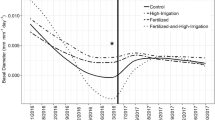Abstract
Examples of nutritional stress in conifer seedlings caused by competing ericaceous species (e. g. Calluna andKalmia), have been reported in several parts of the world. Nutritional stress (primarily N deficiency) has been reported in Sitka spruce (Picea sitchensis) plantations growing in association with an ericaceous species, salal (Gaultheria shallon), in coastal British Columbia. Nutritional interference by salal was investigated on a chronosequence of sites up to 10 yr after clearcutting and slashburning. No direct evidence for an allelopathic contribution to the N stress was obtained. However, the rapid accumulation of salal fine roots and rhizomes, and the nutrients contained therein, provides a partial explanation for the observed stress symptoms. Soil analyses and seedling bioassays demonstrated a reduction in fertility in the period 8 to 10 yr after clearcutting and slashburning in comparison to the period 2 to 4 yr, which is believed to impose further nutritional stress on Sitka spruce. It is concluded that the nutritional stress in these Sitka spruce plantations is caused by a combination of (1) salal competition for nutrients and their subsequent immobilization in salal biomass, and (2) declining site fertility caused by the termination of the flush of nutrients (the “assart period”) that occurs in the immediate post-clearcutting and slashburning period. Sustaining good growth of plantations under such circumstances will require site nutrient management as well as vegetation management.
Résumé
Plusieurs examples de stress nutritif chez les semis de conifères, causé par les végétaux de la famille des éricacées (e. g. Calluna etKalmia), ont été reportés de par le monde. Un stress nutritif (principalement une déficience en azote) a été reporté pour des plantations d' épinette de Sitka (Picea sitchensis) croissant sur la côte ouest de la Colombie Britannique en association avec une espèce de la famille des éricacées, salal (Gaultheria shallon). L'interférence nutritive induite par salal a été étudiée le long d'une chronoséquence jusqu'a 10 ans après la coupe et le brûlage controlé. Aucune évidence d'intèférence d'ordre allélopathique par salal fut obtenue. Cependant, l'accumulation rapide et abondante de racine de salal, accompagnée d'une immobilisation des éléments nutritifs dans la biomasse de salal, offrent une explication adéquate pour une partie du stress nutritif reporté. Autant les analyses de sol que les essais avec les semis d'épinette de Sitka indiquent une diminution de fertilité entre 8 et 10 ans après la coupe et le brûlage controlé comparativement à 2 et 4 ans, ce qui ajoute au stress nutritif de l'épinette de Sitka. Les auteurs conluent que le stress nutritif reporté chez les plantations d'épinette de Sitka est causé par l'effet combiné (1) de la compétition par salal pour les éléments nutritifs et leurs immobilisations subséquentes dans la biomasse de salal, et (2) du déclin de la fertilité du site causé par la terminaison de l'influe d'éléments nutritifs associés avec la coupe et le brûlage controlé. Le maintien d'une croissance adéquate de ces plantations exige une intervention au niveau du site et de la végétation indésirable.
Similar content being viewed by others
References
Cole, D.W. and Rapp, M.: 1981, Elemental cycling in forest ecosystems (P: 341–409), in Reickle, D.E. (ed),Dynamic properties of forest ecosystems. Cambridge University Press. Cambridge.
Covington, W.W.: 1981,Ecology 62, 41.
Germain, A.: 1985, Fertilization of stagnated Sitka spruce plantations on northern Vancouver Island. M.Sc. Thesis. Univ. of British Columbia, Vancouver, B.C., Canada.
Green, R.N., Courtin, P.J., Klinka, K., Slaco, R.J. and Ray, C.A.: 1984, Site diagnosis, three species selection, and slashburning guidelines for the Vancouver Forest Region. Land Management Handbk. #8. Ministry of Forests, Victoria, B.C., Canada.
Handley, W.R.C.: 1963, Mycorrhizal association andCalluna heathland afforestation. For. Comm. Bull. 36, H.M.S.O., London.
Klinka, K.: 1976, Ecosystem units — their classification, mapping and interpretation in the University of British Columbia Research Forest. PhD thesis, Fac. For., Univ. British Columbia, Vancouver, B.C.
Krause, H.H. and Ramlal, D.: 1986,Can. J. Soil Sci. 67, 943.
Lewis, T.: 1982, Ecosystems of the Port McNeill block 4 of Tree Farm Licence 25. Internal Report, Western Forest Products Ltd., Vancouver, B. C.
Mallik, A.U.: 1987,For. Ecol. Manage 20, 43.
McDonald, M.A.: 1989, Competition for nutrients and chemical interference by salalGaultheria shallon Pursh. Vegetation management: An integrated approach, Proc. of the fourth annual Vegetation Management Workshop. FRDA report 109, Ministry of Forests, Victoria, B.C.
Messier, C. (in preparation). Below-ground factors affecting conifer seedling growth in salal-dominated sites in Coastal British Columbia. PhD thesis. Fac. For. Univ. of British Columbia, B.C., Canada.
Miller, H.G. and Miller, J.D.: 1987, Nutritional requirements of Sitka spruce (P: 75–83), in Hendersen, D.M. and Faulkner, R. (eds), Sitka spruce. Proc. of the Royal Society of Edinburgh. Section B (Biological Sciences).
Robinson, R.K.: 1972,J. Ecol. 60, 219.
Rose, S.L., Perry, D.A., Pilz, D. and Schoeneberger, M.M.: 1983,J. Chem. Ecol. 9, 1153.
Sabhasri, S.: 1961, An ecological study of salal,Gaultheria shallon, Pursh. PhD thesis, University of Washington, Washington, USA.
Weetman, G.F., Fournier, R., Barker, J., Schnorbus-Panozzo, E. and Germain, A.: 1990a,Can. J. For. Res. 12, 1501.
Weetman, G.F., Fournier, R., Schnorbus-Panozzo, E. and Barker, J.: 1990b, Post-burn nitrogen and phosphorus availability in Coastal British Columbia cedar/hemlock forests and the use of fertilization and salal eradication to restore productivity, in Gessel, S.P. (ed), Sustained productivity of forest lands. Proceedings of 7th North American Forest Soils Conference, Friesen Press, Vancouver, B.C.
Author information
Authors and Affiliations
Rights and permissions
About this article
Cite this article
Messier, C., Kimmins, J.P. Nutritional stress inPicea sitchensis plantations in coastal British columbia: The effects ofGaultheria shallon and declining site fertility. Water Air Soil Pollut 54, 257–267 (1990). https://doi.org/10.1007/BF02385245
Issue Date:
DOI: https://doi.org/10.1007/BF02385245




